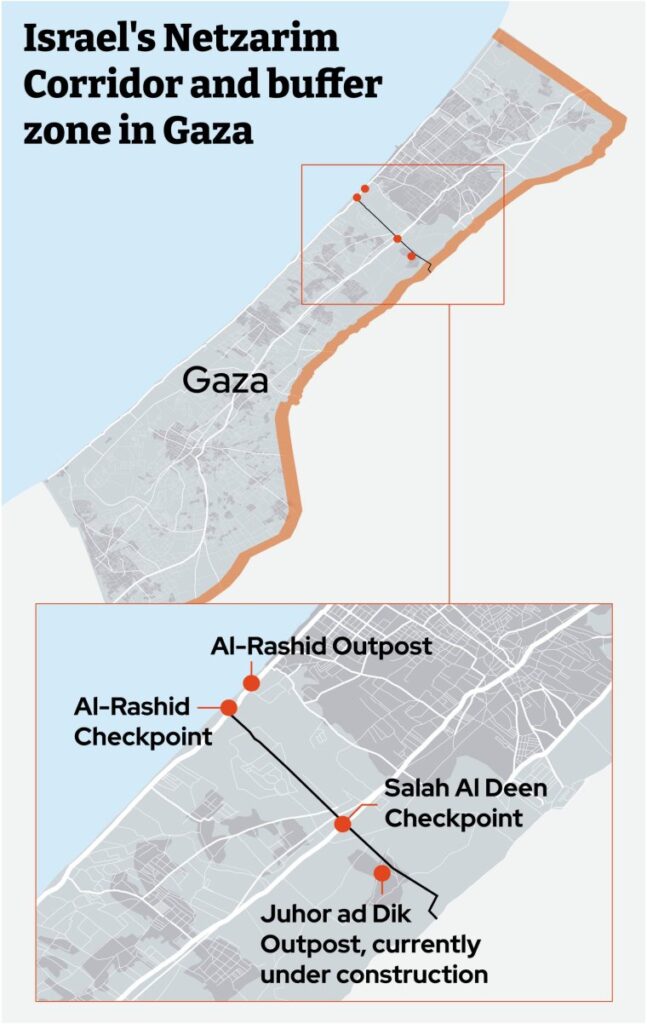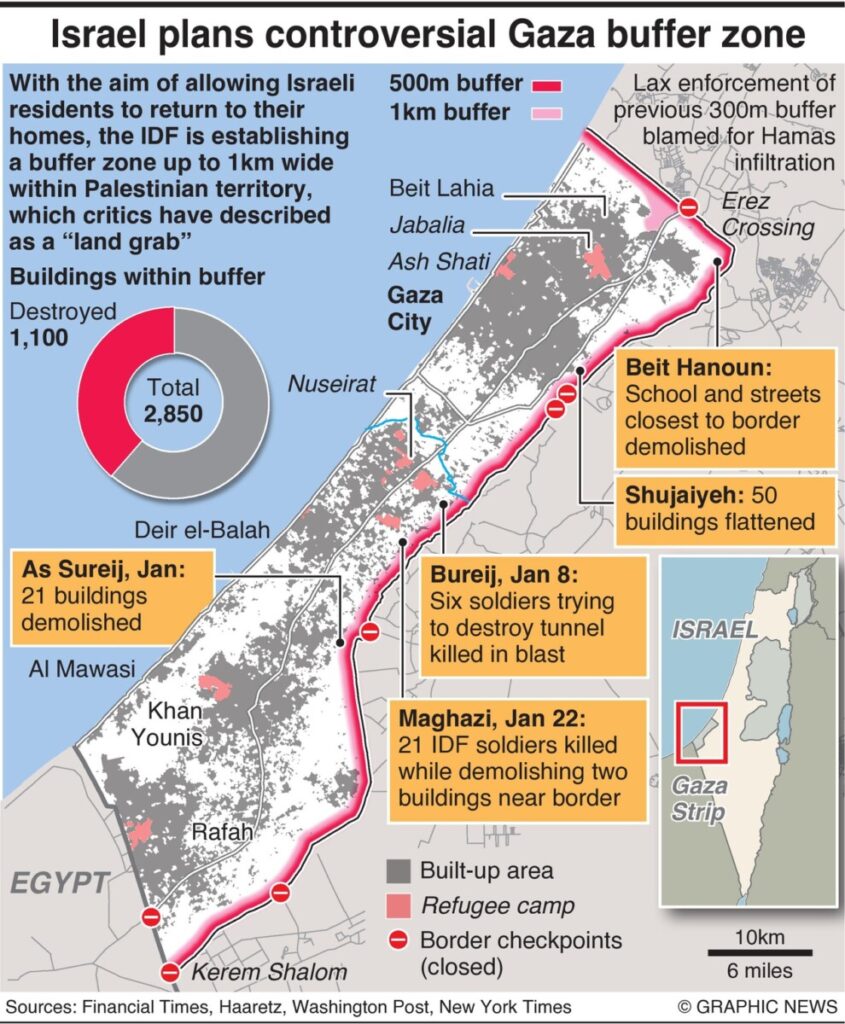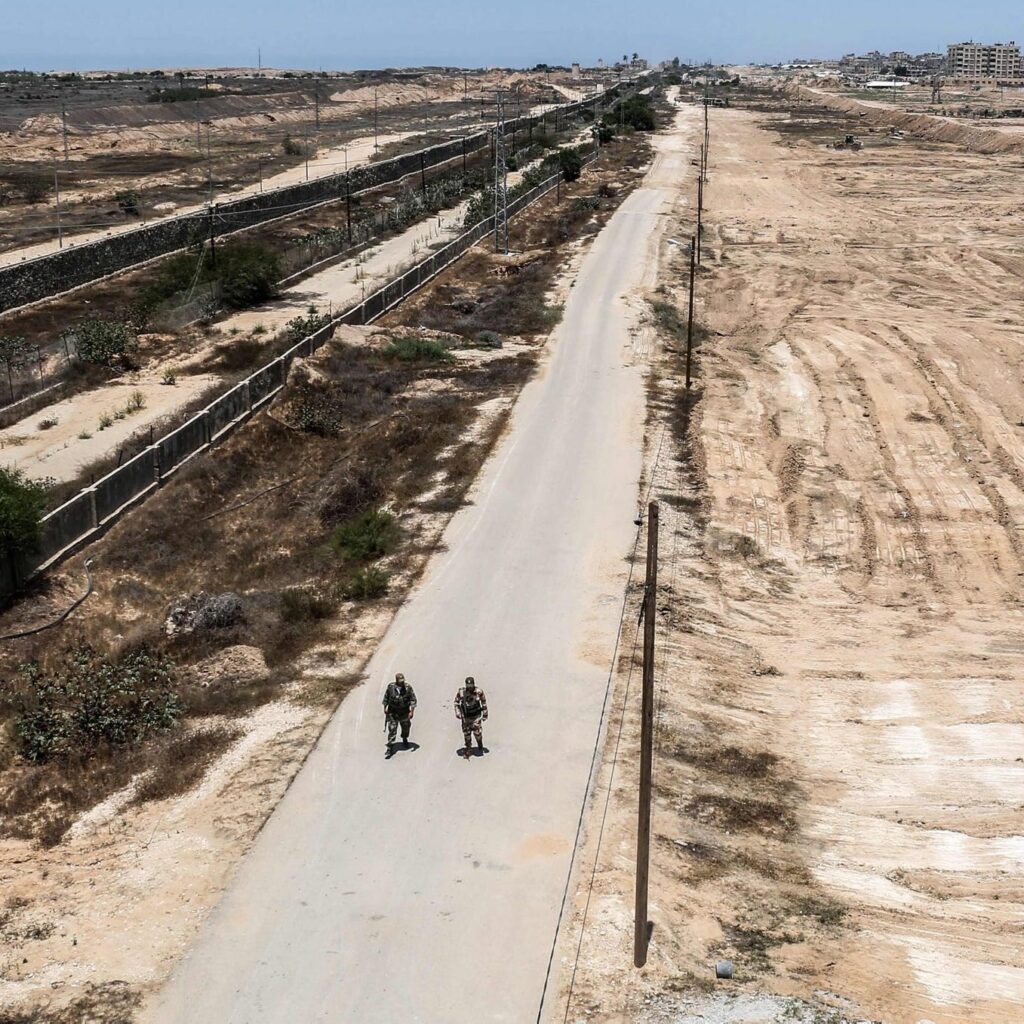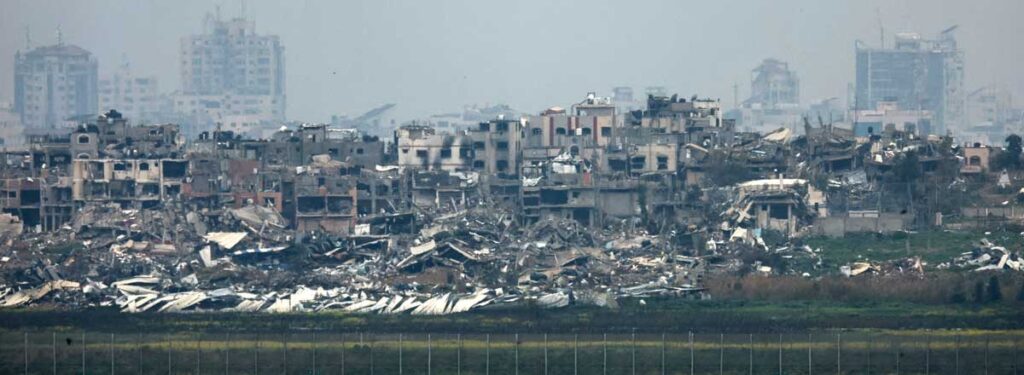
4. The Netzarim Corridor
This “line” reveals their intentions for Gaza and its gas fields. These gas fields are adjacent to the northern parts of Gaza.

When the invasion of Rafah began on May 7th, an additional IOF brigade moved into the Jabaliya area in north Gaza. There has been extensive attacks, massacres, atrocities and killings in Jabaliya and its surrounding areas. The intention behind these attacks was to force the inhabitants to flee to the south, thus implementing the ‘depopulation ‘ of the north. Intentions precede actions. From these actions , we can see how the game-plan is turning into reality.

The Netzarim Corridor is named after an Israeli settlement that used to sit on the coastal route — the second “finger” of then-Israeli Prime Minister Ariel Sharon’s “five fingers” strategy that envisioned carving Gaza into segments, all under Israeli security control. The plan was only partially implemented before Sharon — once a champion of settlements — ordered an Israeli withdrawal from Gaza in 2005.
The Israeli military began bulldozing a path for its armored vehicles soon after declaring war against Hamas on October 7th. Two weeks later, Nethanyahu told Biden about the idea of a pier to be built adjacent to this the Netzarim Axis, as this would have great military value in controlling the northern parts of Gaza. Washington quickly adopted this idea.
The occupation established the Netzarim settlement in 1977, 5 kilometers from Gaza City, with an area estimated at 2,325 acres. . While the total area that the occupation controlled to secure the settlers was about 4,300 acres. On August 15, 2005, the Israeli army began evacuating the settlers. Air-conditioned housing units, electrical power infrastructure, toilets and bathrooms were brought to the site. The phrase “Welcome to the Netzarim base” was written on a concrete barrier at the outposts on the coastal road. The Netzarim Corridor – which is currently controlled by Israel – is among the negotiating points between Tel Aviv and the Islamic Resistance Movement ( Hamas ), which demands the withdrawal of the Israeli army from it and from the settlement outposts established on it. “It’s no surprise that Israel went back and established this as a new corridor,” said Lt. Col. Jonathan Conricus, a fellow at the Foundation for Defense of Democracies and a former IDF spokesman. “The terrain is the most conducive there and it suits the military purposes.”
The Netzarim axis was among the first targets for Israeli troops after they invaded Gaza in response to the Hamas-led attack on Oct. 7, pushing forward to cleave the Strip in two.
By Nov. 6, troops had cut an informal, winding track to the sea that allowed armored vehicles to reach al-Rashid Road, a major north-south thoroughfare that runs along Gaza’s coast. In February and March, Israeli troops formalized the corridor by building a straight road a few hundred meters to the south. The last section of the road, nearest to the coast, was completed between March 5 and March 9, satellite imagery shows. The IDF says the road enables military vehicles to travel from one side of the Strip to the other in just seven minutes, giving soldiers speedy and unimpeded access to north and central Gaza. It was used as a base of operations for recent IDF attacks in Zeitoun, in northern Gaza, said one Israeli military official, speaking on the condition of anonymity in line with IDF protocol. The corridor bisects Gaza’s only two major north-south roads — Salah al-Din Road, in the middle of the territory, and al-Rashid Road along the coast. The IDF began building forward operating bases at both points in early March. Next to both bases, on roads leading north, are structures that appear to be “long parallel intake hallways” leading to a central compound.
The IDF acknowledged that soldiers used “cautionary fire” as Gazans, including “armed terrorists,” approached the corridor. The al-Rashid outpost also featuresobservation points and a possible sentry post. The forward operating base on al-Rashid Road sits next to a jetty constructed in mid-March to receive aid for distribution by the World Central Kitchen charity. The U.S. floating pier is expected to be in the same area, with IDF troops providing security for shipments by sea.
“Welcome to Netzarim Base,” reads the blue graffiti on the concrete barriers outside. At night, bright white flood lights are visible for miles around. “It is the only place in Gaza that is lit,” said one 29-year-old woman who lives just south of the base, speaking by phone on the condition of anonymity out of fear for her safety. “They usually go to an area and leave afterward,” she said of Israeli troops, adding that in Netzarim they look set to stay. The road, will have three lanes: one for heavy tanks and armored vehicles, another for lighter vehicles and a third for faster movement , and that the Netzarim Corridor would be used “to enable destruction of the underground infrastructure of Hamas and its resistance pockets in the north of the Gaza Strip.” It also included a second corridor further south that he called the Sufa Corridor. The plan has not been adopted by the IDF, but it includes elements that are coming into existence, including the Netzarim Corridor.
Lt. Col. Shimon Orkabi, commander of Battalion “601” of the Combat Engineering Corps, said that the soldiers were busy destroying any remaining infrastructure in the buffer area. “It basically opened up this entire space of territory to us, allowing us to control everything that happens in this corridor”. He added that the Israeli military used a “large amount of mines and explosives” to demolish buildings in the buffer zone, and that the remaining buildings in the area will “probably disappear soon.”
The Israeli occupation army is building and developing two settlement outposts on what it described as a strategic road that divides the Gaza Strip into two halves. The occupation army calls the construction and development of the two settlement outposts the “Netzarim Corridor,” describing it as a long-term achievement, and confirms that the corridor was built to last.
On the other hand, the Israeli army considers the construction and control of the corridor an achievement achieved through its war on Gaza, and wants its occupation of the site to continue for a long period of time, which the Hamas movement does not accept.
In a video shared on TikTok, Israeli soldiers can be seen destroying what appears to be the entrance of the Turkish-Palestinian Friendship Hospital. Posted by an Israeli soldier on the social media platform on February 22 and since deleted, the video also shows troops in an armored vehicle driving into the medical complex.
Let’s look at the map below. We see that in the recent invasion that started on May 6th. The IOF went into the north part of Gaza, we find that the most of the genocide took place in the Jabalia refugee camp. The IOF spent 3 weeks there. Intense fighting occurred in the areas around the north such as Beit Lahiya and Beit Hanoun. The aim was to push the Gazans out of North Gaza, and refuse to allow those who lived there, to return.

In the south, the IOF invaded Rafah, and continues its genocide there. The aim of this was to pressure Egypt to allow the Gazans into the Sinai. At around the same time, the US built the infamous pier, which is adjacent to the Netzarim Corridor. It turned out to be a huge embarrassment for the US Navy when the pier broke away and drifted onto a beach on the Israeli side. In trying to hook up with the pier to bring it back to its original point, two navy ships got beached! This pier would enable the US military to support the IOF in its plans to split Gaza into two parts. Both of these moves just re-inforce the overall plan of the two families.
Palestinians remember the so-called “Netzarim junction” existed before 2005; back then, it was largely only accessible to Israeli settlers.

The Netzarim Corridor is an attempt “to control population movement.” A road splitting the strip will make it easier to screen people moving back and forth between the north and south and try to figure out if any of them are Hamas fighters. Many people in Gaza remember what such controls on movement were like before Israel withdrew from the strip.
During a Palestinian uprising against the Israeli occupation from 2000 to 2005, known as the Second Intifada, the so-called “Netzarim junction” was closed off entirely. It became known as a hotspot for clashes between Palestinians and Israelis. “Israeli soldiers were stationed at the junction full-time, and because Israeli settlers used it, we Palestinians mostly could not,” he said. During this period, Israel tightened its “internal closure” policies, mostly for the security of settlements, leaving only one route between the northern and southern halves of the Gaza Strip. Along this route were the Abu Holi and Matahen checkpoints, which severely limited movement. “The Abu Holi checkpoint was notorious,” Al-Rozzi said, recalling a route from Gaza City to the southern city of Khan Younis that “took days” to travel. “They placed a traffic light there that would only turn red. From red to red. Can you imagine? I remember it vividly.”
Abu Holi was seldom open, Munther Al-Ashi, a lawyer from Gaza City, told CNN. He grew up there and recalls the “almost impossible” movement along the checkpoint in the early 2000s. “It was a barrier of humiliation.” “I remember at that time my brothers and I were selling clothes. We used to go out very early in the morning to head southward. The checkpoint would be open sometimes, but on the way back, we would spend eight or nine hours on average. Sometimes it would remain closed, and people would spend their nights in the streets,” he said. “The memories of that checkpoint are painful,” he said. “Imagine 200 to 300 cars waiting at the checkpoint to be granted passage by Israeli soldiers.”
The Israel-Hamas war has displaced both Al-Ashi and Al-Rozzi from the north to the southern city of Rafah. “If our house in Gaza City has not been shelled, I would like to go back to it. How am I going to do that if there are gates and checkpoints in my way?” Al Rozzi said. “More so, how do we function there if I manage to cross back in? Will there be infrastructure left? Roads I can use?” he said. “I am a teacher. Will there be schools I can teach at? Am I going to be able to access them?”
5. An Israeli “Buffer Zone” Could Shape Gaza’s Post-War Reality
Satellite images show extensive construction work in progress along Egypt’s border with Gaza. By creating a militarized border area inside Gaza, Israel has started shrinking the Palestinian territory while opening the door for future Jewish settlements.
During the very first month of the war in Gaza, in early November 2023, Israel started working on a buffer zone inside the Gaza Strip. It will be about one kilometer wide, stretch along the entire border with Israel, about 60 kilometers, and feature military posts, paved roads and surveillance devices. The area will be off limits to Palestinians – even those who lived or cultivated fields in it before the war.
To create the buffer zone, Israel is currently destroying almost everything in the area it has designated for it, including residential buildings, public structures such as schools, medical clinics and mosques, fields, groves and greenhouses. A soldier involved in this work described it as “flattening everything”. Reservist testimonies confirm that the demolitions are carried out to clear the way for a security zone rather than as a response to intelligence information or findings in the field. Only buildings belonging to UNRWA or donated by the European Union, such as water reservoirs and wastewater treatment facilities are left standing.





Satellite images published by the media show the immense damage caused by the military, including the demolition of entire residential neighborhoods and public buildings hundreds of meters from the border, and the destruction of extensive farmland in other areas. The Israeli military demolished 1,072 of 2,824 structures located a kilometer or less from the border, most of which were homes. The most densely populated area being cleared is near Khan Yunis, where, within a one-kilometer range from the border, 704 of 1,048 buildings – almost 70% – have been demolished.
The destruction in Beit Hanoun is a case in point. Satellite images show an entire neighborhood ruined, including more than 150 residential buildings, schools and two hospitals. The surrounding farmland was destroyed, too. Another example of this policy is the town of Khuza’a, which lies opposite the Israeli kibbutz of Nir Oz and has homes closest to the border. The military demolished the entire town, including residential buildings and mosques, as well as surrounding farmland and greenhouses.
Israel has not officially admitted its intention to create a “security zone” along the border. However, other official statements clarify that Israel considers establishing a buffer zone as crucial for civilian defense. According to one by the military, it “is part of the imperative actions that are needed in order to implement a defense plan that will provide improved security in Southern Israel”. The IDF spox that the military was demolishing buildings in Gaza as part of the buffer zone effort.
Yet, this cannot justify widespread demolition inside Gaza and the creation of a “security zone.” The demolitions carried out by Israel for this purpose are unlawful and constitute a war crime: they are a preventive measure intended to thwart a future threat, and demolition for such purposes is absolutely prohibited. Destroying private property is explicitly prohibited, among other things, as a means to deter, intimidate or retaliate against the civilian population, or to deliberately cause prolonged or permanent damage. In addition, the extensive scope of destruction carried out by Israel violates a basic principle of international humanitarian law, proportionality, which prohibits actions that cause excessive harm to persons not participating in hostilities and their property, relative to the military advantage expected from the action.
Creating a “security zone” inside the Gaza Strip is not a new idea for Israel. Even before the war, the military restricted Palestinian access to areas located some 300 meters from the perimeter fence, though Israel never officially announced this policy or clarified to the Palestinians precisely where access was restricted. The ban was nevertheless enforced by the military through open-fire regulations that allowed shooting Palestinians present in those areas even if they posed no threat. From September 2005, when Israel implemented “disengagement plan” to 6 October 2023 (excluding periods of fighting), at least 88 Palestinians who did not participate in hostilities were killed in these areas. The military has also enforced the ban by spraying herbicides on crops near the fence. Israel’s policy profoundly altered the area along the border. Before the ban, residents cultivated fruit trees and grazed sheep and cattle there. After the ban was imposed, farmers switched to crops that require less care and which the military cannot argue obstruct its field of vision, such as wheat, barley, beans and vegetables.
Creating a “security zone” within the Gaza Strip will drastically change the area, with long-term implications. It will shrink the territory of Gaza, already one of the most crowded areas in the world. Thousands of residents will be unable to return home, communities will be destroyed, and entire lives built over years will be ruined. The widespread damage to farmland will also affect food production capacity in Gaza, harming farmers’ livelihoods and the future nutrition of Gaza residents.
Nazih Abu Rabi’, a 50-year-old father of seven, lived about a kilometer from the border. When the war began, he fled his home and is currently in Deir al-Balah. In late January, a relative told him the military had destroyed his home and olive grove, along with about 20 homes nearby. What he said to B’Tselem field researcher Khaled ‘Azayzeh illustrates the impact of Israel’s policy: “I wasn’t surprised when my nephew told me, but I felt deep sorrow because I lost all my property after years of effort. I put everything I earned into building the house, which was demolished in seconds. I was planning to build another floor for one of my sons, and to build another house on my plot of land. I’m very worried, because I don’t know if we will be able to go back to our land and build there again. I was born and raised on that land, and my father and grandfather before me. I have no other home.”

Israeli forces are destroying farmland and demolishing hundreds of homes as well as schools in Gaza to create an 800-meter buffer zone alongside the border with Israel. Palestinians would be barred from the zone, which Israeli officials claim is needed to allow Israelis to return to settlements surrounding Gaza, which were evacuated after the Hamas-led Operation Al-Aqsa Flood on 7 October. Plans for creating the buffer zone began in the first days of the war and would allow Israeli troops to see and stop anyone approaching the border. Only farmers were allowed to enter the zone.
During protests in 2018, known as the “Great Return March,” Israeli snipers killed 214 Palestinians near the border fence.
Shaul Arieli, a former Israeli colonel, said the creation of a permanent buffer zone inside Gaza would be illegal under international law because Israel would be occupying land beyond its recognized territory. If the buffer zone is completed, Israel would effectively confiscate 16 percent of Gaza’s territory. Using bulldozers and controlled explosions, Israel has destroyed some 1,100 buildings, more than 40 percent of the estimated 2,800 in the proposed zone. Israel is also creating a 320-meter-wide road that will effectively cut the Gaza Strip in two, dividing the north from the south. This is the Netzarim Corridor. Israel forces have so far destroyed 150 buildings to build the road.
Israeli officials say the army will use the road to patrol Gaza until Israeli military operations are complete, which could last months or years. The IOF has taken control of 26 % of the Gaza Strip, building bases and paving roads. Israel’s messianic right is already advancing towards its target. The IOF’s occupation of parts of the Gaza Strip, for an undefined period of time, is one of the most dramatic developments in the current war. The IOF considers Israeli control over these areas as a strategic step, while Israel’s political leadership is pushing to continue the war. In the ongoing ceasefire negotiations, Hamas is demanding that Israel withdraw from areas that have been occupied and to end the war. The army’s activities in the occupied areas are diverse: expanding military bases, building infrastructure and even paving roads.
A senior IOF officer discussing the territory under full IDF control in the heart of Gaza called it “an effort at prolonged occupation”. Conditions for the emergence of a new reality are being created ¨an indefinite Israeli presence in Gaza.
First, the IOF built a buffer zone along Israeli border, razed all the structures within it and prohibited Palestinians from entering. The army also took control of the Philadelphi Crossing on the Egyptian-Gaza border, to prevent Hamas access to Egypt, and also destroyed many of the structures there. Religious settlers in Prime Minister Benjamin Netanyahu’s coalition have made clear their goal of conquering Gaza, forcibly expelling its 2.3 million Palestinian inhabitants, and establishing settlements for Jewish Israelis to live in their place.
6. The US plan to impose a Foreign Administration of Gaza
“We will not accept or allow the presence of a foreigner on our land, whether in the West Bank or the Gaza Strip,” the official spokesperson for the Palestinian presidency said.
The Palestinian presidency issued a statement on Sunday rejecting “Israel’s” proposal for international forces to administer Gaza. “There is no legitimacy for any foreign presence on Palestinian territory, and only the Palestinian people can decide who governs them and manages their affairs,” said the official spokesperson for the presidency. The statement was made in response to comments from an unnamed Israeli security official cited by the Israeli Broadcasting Authority, who stated that the IOF will remain in Gaza until foreign forces take over governance of the Strip. “We will not accept or allow the presence of a foreigner on our land, whether in the West Bank or the Gaza Strip,” said Abu Rudeineh, adding “The Palestinian issue is one of land and statehood, not a matter of humanitarian aid. It is a sacred cause and the central issue for the Arabs.”
A Washington Post opinion piece revealed Israeli Security Minister Yoav Gallant’s detailed plan for Gaza in Gaza, laid out during his recent visit to the United States. A steering committee led by the United States and “moderate Arab partners” would supervise the transition. Security would be overseen by an international force that might include troops from Egypt, Jordan, Abu Dhabi, and Morocco. US troops would provide logistics, command, and control from outside of Gaza, most likely from Egypt. Jordan, Qatar, and Saudi Arabia have reportedly refused requests to take part in a US-led “peacekeeping force” for Gaza once Israel’s genocide of Palestinians comes to a stop, one of the sources stated that troops from the Arab nations would be seen to be “protecting Israel from the Palestinians.” The reported positions of Aman, Doha and Riyadh contrast starkly with those of the Abu Dhabi and Egypt, which have reportedly to participate in the effort. The UAE in June hosted a secret meeting with US and Israeli officials to discuss plans for Gaza after the genocidal war ends. Abu Dhabi has also stepped up with Tel Aviv since 7 October to construct military and intelligence infrastructure on the Socotra Archipelago off the coast of Yemen, under US sponsorship.
Eventually, local security would be handled by a Palestinian force. Both US officials and Gallant agreed that this Palestinian security force “should probably be trained under an existing security assistance program for the Palestinian Authority, headed by Lt. General Michael Fenzel, “a security coordinator” for both “Israel” and the authority based in occupied al-Quds.
Commenting on the last point, the article’s author said, “Gallant is reflecting the judgment of the Israeli defense establishment here, even though Netanyahu publicly has rejected a role for the Palestinian Authority in postwar Gaza.”
Netanyahu pushes against Palestinian Authority Involvement
On June 7, during a meeting of “Israel’s” war cabinet before the talks in Egypt, Netanyahu stated that he does not agree to any role for the Palestinian Authority at the Rafah crossing. Netanyahu’s remark contradicted a policy approved by the war cabinet a few days earlier, which stated that “Israel” would agree to the Rafah crossing being operated by any government entity other than the Gaza government.
The Commissioner-General of the Akef al-Masri, affirmed on June 24 that Israeli Prime Minister Benjamin Netanyahu and his ministers “have not and will not be able to break the will of the Palestinian people in their pursuit of freedom, ending the occupation, establishing a Palestinian state, and achieving the right of return.”
It is noteworthy that the statements from the clans in the Gaza Strip come after Netanyahu acknowledged the failure of his plan, which proposed that Palestinian clans would govern the Strip instead of the Hamas Movement. He reiterated his refusal to hand over administration to the Palestinian Authority or establish a Palestinian state.
At the end of the day, these 2 families always have a habit of concocting various plans, most of which don’t work out. These ideas above are just some examples. Now, we see how the Palestinian resistance is thwarting these plans.
Our next article is titled “The Resistance begins Phase 2 in Gaza “.

